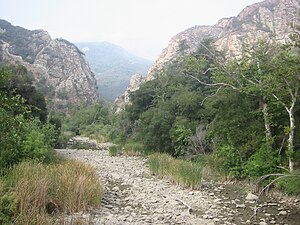Malibu Creek
| Malibu Creek Malaga Creek Maliba Sequit Creek Malibo Creek Topanga Malibu Sequit Creek | |
|---|---|
 Malibu Creek, dry river bed, with the Goat Buttes in the background | |
| Location | |
| Country | United States |
| State | California |
| Region | Los Angeles County |
| Physical characteristics | |
| Source | |
| • location | 4 mi (6 km) |
| • coordinates | 34°07′22″N 118°47′38″W / 34.12278°N 118.79389°W[1] |
| Source confluence | Triunfo Creek and Lobo Canyon Creek |
| • elevation | 760 ft (230 m) |
| Mouth | Malibu Lagoon then Santa Monica Bay, Pacific Ocean |
• location | Malibu, California |
• coordinates | 34°01′54″N 118°40′47″W / 34.03167°N 118.67972°W[1] |
• elevation | 3 ft (0.91 m)[1] |
| Basin features | |
| Tributaries | |
| • left | Medea Creek, Las Virgenes Creek, Cold Creek |
Malibu Creek is a year-round stream in western

Malibu Canyon is a chief pass through the mountains, and Malibu Canyon Road is a major north–south route connecting the coast to the inland valley. Malibu Creek starts at
History
The area around Malibu Creek was for centuries a major area of
The origin of the creek's name likely derives from the Chumash term U-mali-wu, which means "it makes a loud noise there". The Spanish recorded this as 'Malibu', and this spelling appears in the Topanga Malibu Sequit land grant on July 12, 1805.[4]
Sections of the creek were dammed in
Watershed

Malibu Creek has several tributaries draining the Santa Monica Mountains. These include streams draining to Lake Sherwood, and thence via Potrero Valley Creek to Westlake Lake, then down Triunfo Creek to its confluence with Lobo Canyon Creek which is the origin of Malibu Creek. Amongst many other tributaries are Medea Creek, Las Virgenes Creek and Cold Creek. Medea Creek and Malibu Creek join to form Malibu Lake. Further downstream Las Virgenes Creek joins Malibu Creek at Malibu Creek State Park.
River modifications
The Rindge Dam becomes a 100-foot (30 m) waterfall in Malibu Creek State Park, emptying into a perennial deep pool. Eventually the creek empties into the 13-acre (53,000 m2) Malibu Lagoon.
Tapia Water Reclamation Facility discharges treated wastewater into the creek.
Ecology
Malibu Creek and its surrounding area is home to a wide range of flora and fauna endemic to the region. These include a variety of wildflowers,

It is estimated that
The rare plant Malibu baccharis (Baccharis malibuensis) is endemic to the Malibu Creek drainage.[13] Introduced crayfish are a problem as they devour the native fish, aquatic insects, and newts along with eggs and tadpoles of frogs and toads.[14]
Geology
Malibu Creek runs through a section of the Santa Monica Mountains, which is, in part, largely covered by the Conejo Volcanics, a Miocene volcanic field. Several sections of volcanic rock, including the Conejo Volcanics, were formed along the coast of California by significant shifts in the tectonic plate boundaries found along the North American west coast, forcing magma through the crust, which cooled into the rock formations seen today.[15]
Parks
Virtually all of the Malibu Creek watershed falls within the Santa Monica Mountains National Recreation Area; most of Malibu Creek was included in Malibu Creek State Park in 1976. The section near Century Lake is especially popular with swimmers, climbers, and photographers.
See also
References
- ^ a b c U.S. Geological Survey Geographic Names Information System: Malibu Creek
- ^ "Malibu Creek Watershed". Malibu Creek Watershed Council. Archived from the original on April 8, 2010. Retrieved June 13, 2010.
- ^ U.S. Geological Survey. National Hydrography Dataset high-resolution flowline data. The National Map Archived 2012-03-29 at the Wayback Machine, accessed March 16, 2011
- ^ Erwin Gustav Gudde (1974). California Place Names. University of California Press. p. C-190. Retrieved June 13, 2010.
- ^ Harrison, Scott (January 31, 2017). "From the Archives: 1952 Opening of Malibu Canyon Road". Los Angeles Times. Retrieved May 20, 2021.
- ^ Smith, Hayley (December 15, 2022). "Low on water, but high on celebrity, Las Virgenes seeks wastewater purification facility". Los Angeles Times. Retrieved December 16, 2022.
- ^ Elam, Stephanie (February 7, 2024). "LA County captured enough rain this week to provide water to 65,600 residents for a year". CNN. Retrieved February 8, 2024.
- ^ McGrath, Rachel (August 29, 2014) "Drought taking toll on Westlake Lake" Ventura County Star
- ^ "Nature". www.malibucreekstatepark.org. Retrieved October 20, 2022.
- ^ 2007 Federal Recovery Outline for the Distinct Population Segment of Southern California Coast Steelhead (PDF) (Report). The National Marine Fisheries Service. September 2007. Archived from the original (PDF) on May 28, 2010. Retrieved June 13, 2010.
- S2CID 32490944.
- ^ a b Rosi Dagit; Stevie Adams; Sabrina Drill (April 2009). "Die off and current status of southern steelhead trout in Malibu Creek, Los Angeles County, USA". Bulletin of the Southern California Academy of Sciences. Retrieved June 12, 2010.
- ^ Flora of North America: B. malibuensis
- ^ Sahagun, Louis (April 4, 2015). "Volunteers remove invasive crayfish from Malibu Creek watershed". Los Angeles Times.
- ^ "Malibu Creek SP". CA State Parks. Retrieved October 20, 2022.


